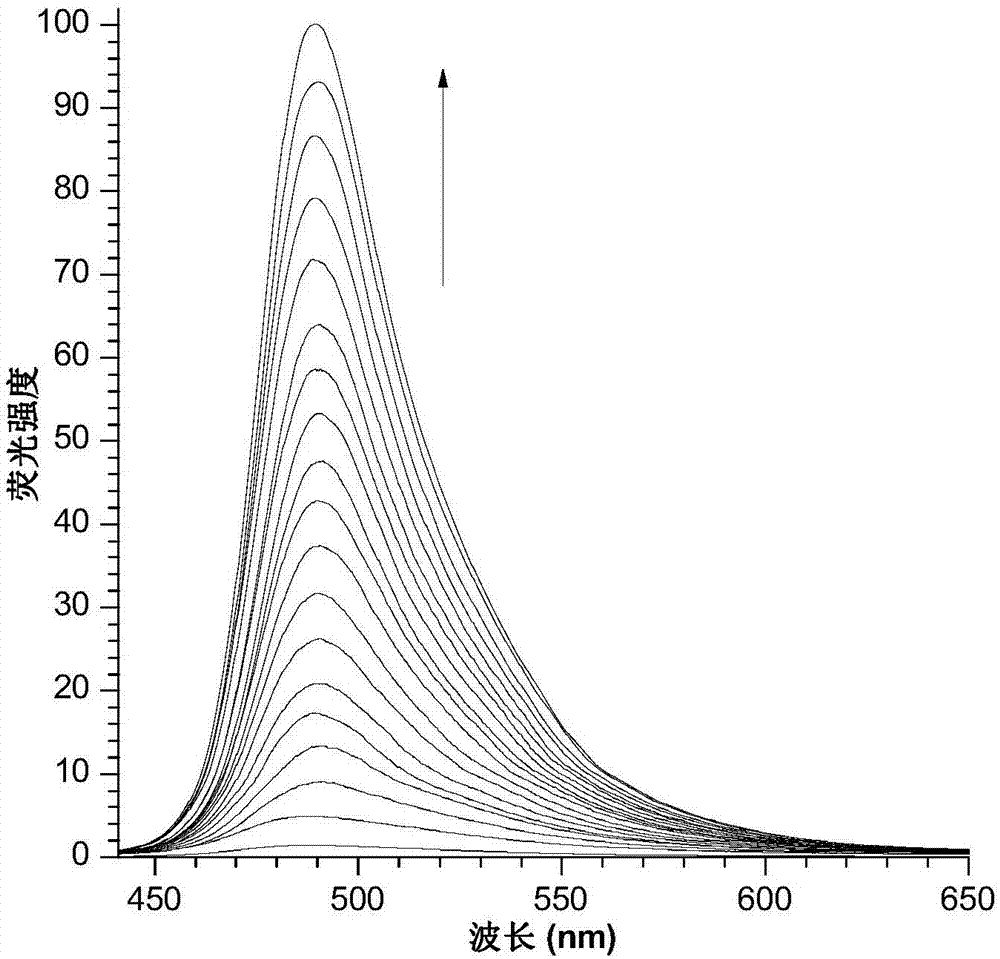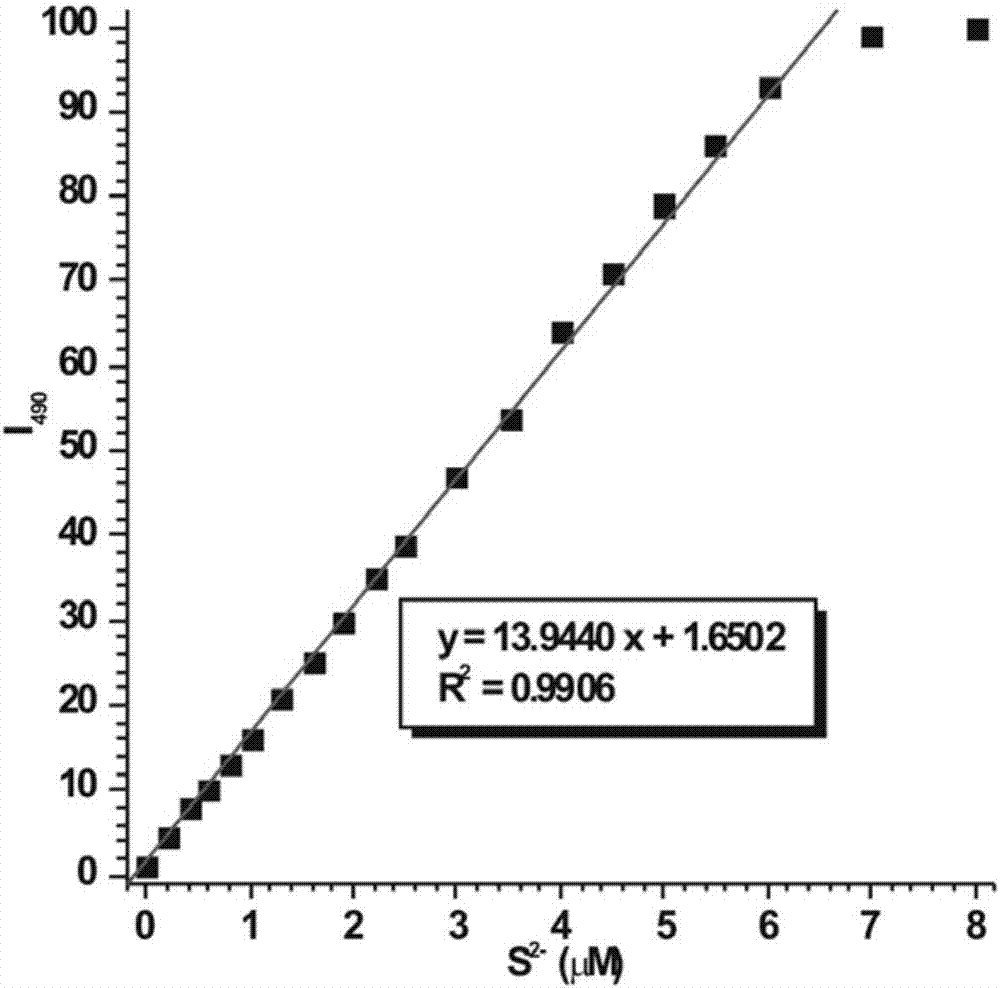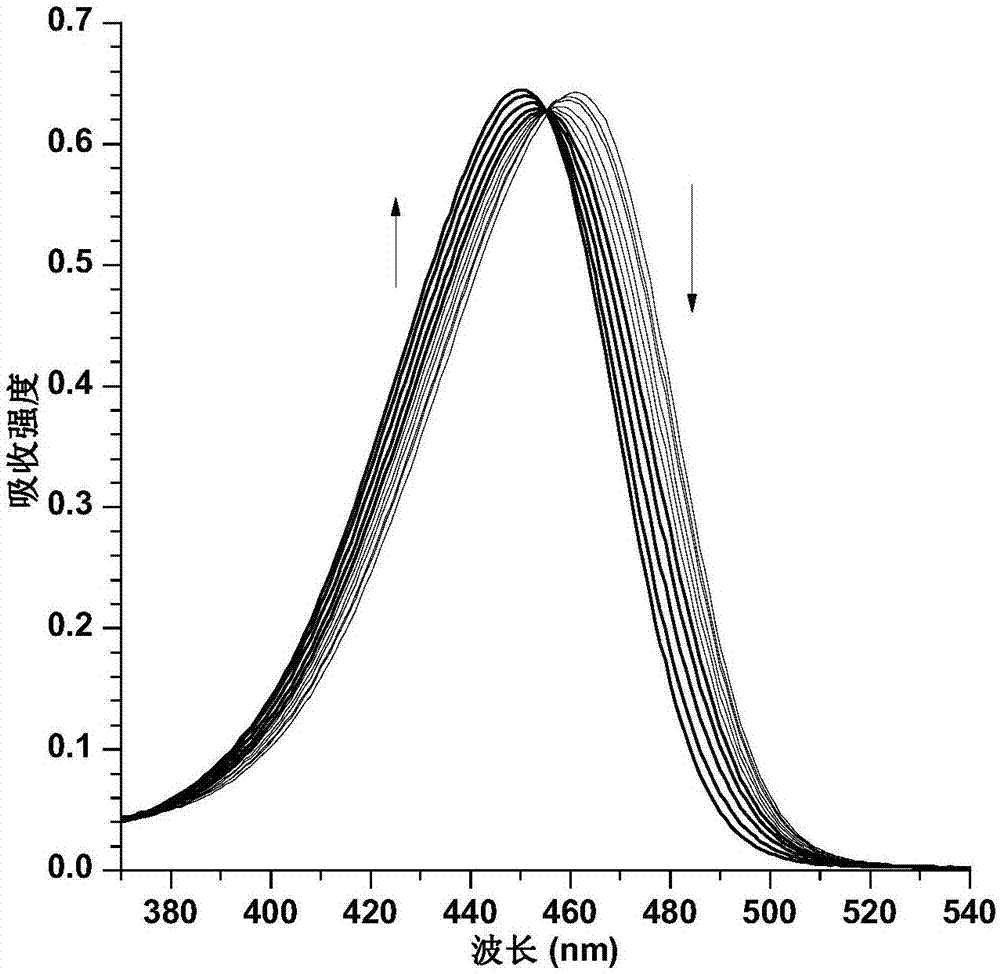Complex for rapidly detecting sulfide ions, and quantitative analysis method and applications thereof
A quantitative analysis and complex technology, applied in analytical materials, measuring devices, material analysis by observing the effect on chemical indicators, etc. "Natural eye" detection, good water solubility and biocompatibility, ultra-high selectivity
- Summary
- Abstract
- Description
- Claims
- Application Information
AI Technical Summary
Problems solved by technology
Method used
Image
Examples
Embodiment 1
[0039] A complex for rapid detection of sulfide ions and its quantitative analysis and application uses a coumarin derivative-copper ion complex as a sulfide ion fluorescence sensor to detect sulfide ions in a solution. The method mainly includes the following steps:
[0040] 1) Prepare a HEPES buffer solution with a concentration of 10 mM and a pH of 7.4; prepare a DMSO solution of compound C1 with a concentration of 2×10 -5 mol / L. Take 1mL of the DMSO solution of C1 above and place it in a 10mL colorimetric tube, and dilute to volume with HEPES buffer solution to obtain a concentration of 2×10 -6 mol / L, C1 solution with HEPES-DMSO volume ratio of 9:1 as solvent.
[0041] Then, in the solution of the above compound C1, a concentration of 1×10 -2 mol / L Cu(NO 3 ) 2 ·3H 2 O aqueous solution 5 μL (negligible effect on the total volume), to obtain a solution of the complex C1-Cu.
[0042] 2) Prepare a concentration of 3.0×10 with deionized water -3 mol / L Na 2 S aqueous so...
Embodiment 2
[0048] The solution of complex C1-Cu of the present invention is to S 2- The ultraviolet-visible absorption spectrometry titration, comprises the steps:
[0049] 1) Prepare a HEPES buffer solution with a concentration of 10 mM and a pH of 7.4; prepare a DMSO solution of compound C1 with a concentration of 7×10 -5 mol / L. Take 1mL of the DMSO solution of C1 above and place it in a 10mL colorimetric tube, dilute to volume with HEPES buffer solution to obtain a concentration of 7×10 -6 mol / L, C1 solution with HEPES-DMSO volume ratio of 9:1 as solvent.
[0050] Then, in the solution of the above compound C1, a concentration of 2×10 -2 mol / L Cu(NO 3 ) 2 ·3H 2 O aqueous solution 5 μL (negligible effect on the total volume), to obtain a solution of the complex C1-Cu.
[0051] 2) Prepare a concentration of 6.0×10 with deionized water -3 mol / L Na 2 S aqueous solution.
[0052] 3) Take 3 mL of the complex C1-Cu solution prepared in step 1) and place it in a quartz cuvette, and ...
Embodiment 3
[0055] The spectral response of the solution of the compound C1-Cu of the present invention to common anions mainly comprises the following steps:
[0056] 1) Prepare a HEPES buffer solution with a concentration of 10 mM and a pH of 7.4; prepare a DMSO solution of compound C1 with a concentration of 2×10 -5 mol / L. Take 1mL of the DMSO solution of C1 above and place it in a 10mL colorimetric tube, and dilute to volume with HEPES buffer solution to obtain a concentration of 2×10 -6 mol / L, C1 solution with HEPES-DMSO volume ratio of 9:1 as solvent.
[0057] Then, in the solution of the above compound C1, a concentration of 1×10 -2 mol / L Cu(NO 3 ) 2 ·3H 2 O aqueous solution 5 μL (negligible effect on the total volume), to obtain a solution of the complex C1-Cu.
[0058] 2) Prepare Na separately 2 SO 3 ,NaHSO 3 , Na 2 SO 4 , Na 2 S 2 o 3 ·5H 2 O,NaN 3 ,NaCN,KClO 3 ,NaF,NaCl,KBr,KI,NaIO 3 , Na 2 HPO 4 12H 2 O,Na 3 PO4 ,NaOAc·3H 2 O,Na 2 CO 3 ,NaHCO 3 , NaSC...
PUM
 Login to View More
Login to View More Abstract
Description
Claims
Application Information
 Login to View More
Login to View More - R&D
- Intellectual Property
- Life Sciences
- Materials
- Tech Scout
- Unparalleled Data Quality
- Higher Quality Content
- 60% Fewer Hallucinations
Browse by: Latest US Patents, China's latest patents, Technical Efficacy Thesaurus, Application Domain, Technology Topic, Popular Technical Reports.
© 2025 PatSnap. All rights reserved.Legal|Privacy policy|Modern Slavery Act Transparency Statement|Sitemap|About US| Contact US: help@patsnap.com



